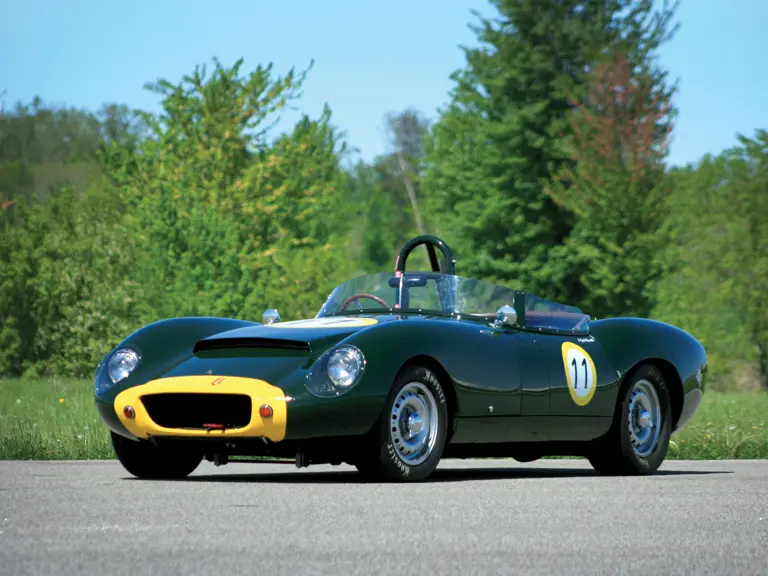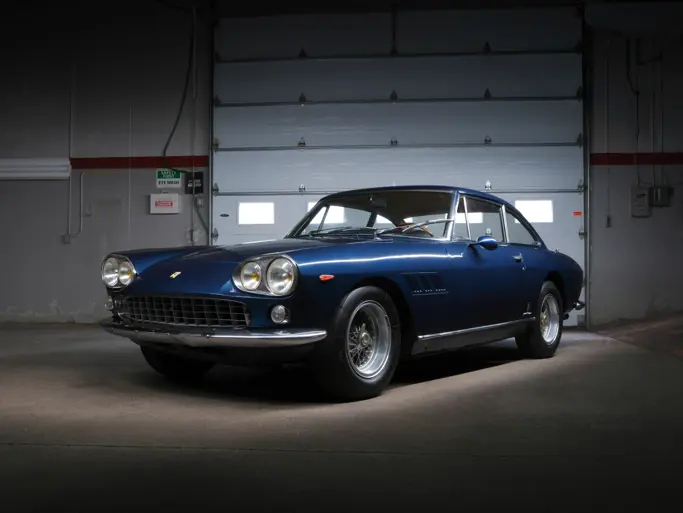
1959 Lister Costin
{{lr.item.text}}
$363,000 USD | Sold
{{bidding.lot.reserveStatusFormatted}}
- High performance 3.8-liter Jaguar engine
- Corresponding transmission
- Triple Weber DCOE carbs
- Built on 1959 XK 150S chassis
- Fresh $100,000 mechanical and cosmetic restoration
- Fully logbooked for SVRA
- "One-off” design by Frank Costin executed by Williams & Pritchard in the 1950s
- Known history
The history of this interesting Costin Jaguar starts in 1939. The wiry little ERA (English Racing Automobiles) racers had been tearing up the 1.5-liter and even 2-liter classes in Europe but didn’t have a big enough engine to race against the German Mercedes-Benz’ or Auto Unions or even the Italian Alfa Romeos in that period of the European Driver’s Championship and are now most often referred to as Grand Prix races.
Reid Railton, who designed the ERA, had gone back to America, and his assistant Peter Berthon was tasked with coming up with a competitive racecar for the series now considered Formula 1; then called the European Championship. Unfortunately, it was 1939 and Europe was preoccupied with the imminent World War, meaning the company’s backers had other priorities. However, the British press was all over the idea, hoping the country could beat the Germans at something before the unpleasantness began.
Berthon was stuck for an engine, but he continued with ERA practice and tried boring out the Riley-derived twin-cam six-cylinder that had been so successful in 1.5-liter form. The bored-out version was claimed to be 2.6 liters, but engineers had concluded that about 2.2 liters was the biggest it could have been. Finally, the ambitiously named GP1 took to the track for the 1939 International Trophy at Brooklands, fitted with a 1.5-liter engine. It was practically a moving chicane and was withdrawn after practice.
Berthon pressed on; GP1 was shipped to Reims for the French Grand Prix, but even though it was clocked at 160-mph on the straight, it broke before the start. GP1 finally started a race at Albi, driven by Arthur Dobson, who was leading when he crashed. One more attempt before the war ended in a Did Not Start (DNS). A second car, GP2, was completed after the war but parked in 1950 after a similar record. GP1’s final outing resulted in a tremendous fire that all but destroyed it. Fortunately, there was a spare chassis available (which wouldn’t fit anything else), and it was rebuilt.
The next chapter can be constructed through letters to a British motor magazine in the late 1960s. In the early 1950s, Ken Flint and Paul Kelly bought ERA GP2 fitted with an Austin A90 engine from an employee at the works. The motor wasn’t strong enough for a racecar, so they found and installed a C-Type Jaguar engine, got it working properly and sold the now-much-faster car to J. Nichollson in Scotland.
Nichollson promptly ordered a sleek aluminum Costin-styled coupe body from coachbuilders Williams & Pritchard for the impressive sum of £1,250 – ten times the price of a brand new Ford. At this point, GP2 had a four-speed Jaguar transmission up front and its own ERA transmission in the rear, making a usable six-speed setup. It would certainly have taken some concentration to drive.
In any event, Nichollson sold GP2 to Stephen Lee; when Lee had enough of it, he advertised it for sale as GP1. This drew the attention of reader Gordon Chapman of Kineton, Warwick, who knew the car couldn’t be GP1 – he already owned it. This meant it had to be the missing GP2. Chapman removed the Williams & Pritchard body and concentrated on restoring GP2. It survives today, along with GP1, which competed at the Silverstone Classic in 2005 and the Goodwood Revival in 2007.
Meanwhile, another notable figure in British vintage racing weighed in with his recollections. He was Duncan Rabagliati of London, who had seen GP2 race at the Barbon hillclimb in 1963 registered as 933 BAO, with its handsome coupe body and with Nichollson at the wheel. Rabagliati also recalled seeing Ken Flint win a race in the cycle-fendered (and original-bodied) GP2 at Aintree in the early 1950s.
At this point, the Honorable Patrick Lindsay enters the picture. A descendent of the Earl of Crawford in 16th-Century Scotland, Patrick Lindsay raced almost everything he owned – including his tow vehicles. His competition record extended from 1955 into the 1980s in a wide variety of cars, and contemporary accounts describe him as a gentleman, sportsman, racing driver, aviator, auctioneer and head of Christie's Old-Masters Department.
Lindsay founded Christie's Motor Car Department more than 30 years ago and was a keen VSCC racer. He drove Maseratis, Alfas and Jaguars, but his particular favorite was the ex-Bira ERA "Remus," one of a pair of ERAs once owned by the racing Prince from Siam.
At Silverstone in the mid-1970s, race days had their rituals and their characters. Patrick Lindsay would fly in to Silverstone in his own Spitfire, landing it inside the track after some aerobatics to amuse the crowd. On the ground, he would switch to something equally ostentatious, such as Remus.
Sometime in the late 1970s, Lindsay bought the Williams & Pritchard Costin body that was removed from GP2. It is also likely that Gordon Chapman installed it in a Jaguar 150 frame himself and sold Lindsay the complete package. In any event, Patrick Lindsay must have loved the car, because he owned it until he died and drove with it in numerous races and events. With its lightweight body and current XK 150S powertrain, it remains fiercely competitive.
Patrick Lindsay’s widow, Lady Lindsay, and her son, Ludovic, sold the car to a music industry producer and musician who recorded Peter Green (from the first generation of Fleetwood Mac in the late 1960s) and played on his albums and also played keyboards and guitar with The Who in the early days. Now he's a country gentleman and enjoys racing.
The bodywork, a “one-off” design by Costin executed by Williams & Pritchard in the 1950s is remarkable in that British aerodynamicist Frank Costin was behind it. Frank and his brother Mike were silent, yet powerful forces in the auto industry for over four decades. While Mike helped make one of the greatest engines ever, the Cosworth DFV (Costin and Keith Duckworth), Frank was responsible for some of the most iconic shapes of all time.
Costin was an engineer with the de Havilland Aircraft Company when, in 1954, brother Mike, a former de Havilland engineer then working for Colin Chapman and Lotus Engineering Ltd., asked him to design an aerodynamic body for a new racing car. Intrigued by the idea of applying aerodynamics to racecars, Costin designed the body for the Lotus Mark VIII. Frank Costin was also known as an early force in the development of the monocoque chassis, now commonplace in racecar construction, of which Chapman was another early advocate.
In 1956, when Chapman was commissioned by Tony Vandervell to design a Grand Prix racing car to challenge Maserati and Ferrari dominance of Formula 1, Chapman recommended Costin to Vandervell as the body designer. Costin designed the body for the Vanwall that won the first Grand Prix Constructors' Championship in 1958 with Stirling Moss, Tony Brooks and Stuart Lewis-Evans as drivers. Ferrari driver Mike Hawthorn was able to capture the Driver's Championship by a single point over Moss to prevent a sweep of the two important world titles by the British Vanwall team.
He later joined with Brian Lister to help in the creation of the famous Lister Jaguars. The original ‘Knobbly’ Jaguars had the distinct feature of a low frontal area which required a huge hump to clear the engine. With protruding fenders, the car became distinctly known as the ‘Knobbly’. Although purposeful, the ‘Knobbly’ was unsteady at high speeds which caused Brian Lister to go back to drawing boards with Frank Costin to design a much more aerodynamically efficient body. By 1959 all Listers used the new Costin design and the ‘Knobbly’ was out.
The body on this particular car was originally fitted to an ERA chassis powered by a Jaguar and raced from “new” until the late 1970s. After that, the body was removed and refitted to its current 1959 XK 150S chassis. It is noted that by retaining the 3.8-liter S engine and transmission, reported as original to the XK 150S chassis is quite valuable by itself. Costin-designed bodywork executed by respected professionals only adds to its exclusive history.
The British Racing Green Costin Jaguar is in superb mechanical condition, as close examination will disclose, benefitting from a fresh $100,000 nut-and-bolt mechanical and cosmetic restoration that was carried out by its current owner – a prominent collector of Jaguar sports and racing cars. During this timeframe the owner-collector built and installed a separate high performance 3.8-liter Jaguar racing engine fed by triple Weber DCOE carburetors. The suspension geometry was professionally set up, and a custom rollbar and cage was installed. This element was designed to have removable interior members to make the car comfortable for two-person touring.
While prior to restoration, this car made for a fun weekend roadcar, it is now fully logbooked for SVRA, and is ready for race or tour. This spectacular and storied English roadster is welcome and capable for either the Monterey Historics or the Colorado Grand and is eligible for almost any other historic event in the United States or Europe.


 | Auburn, Indiana
| Auburn, Indiana


